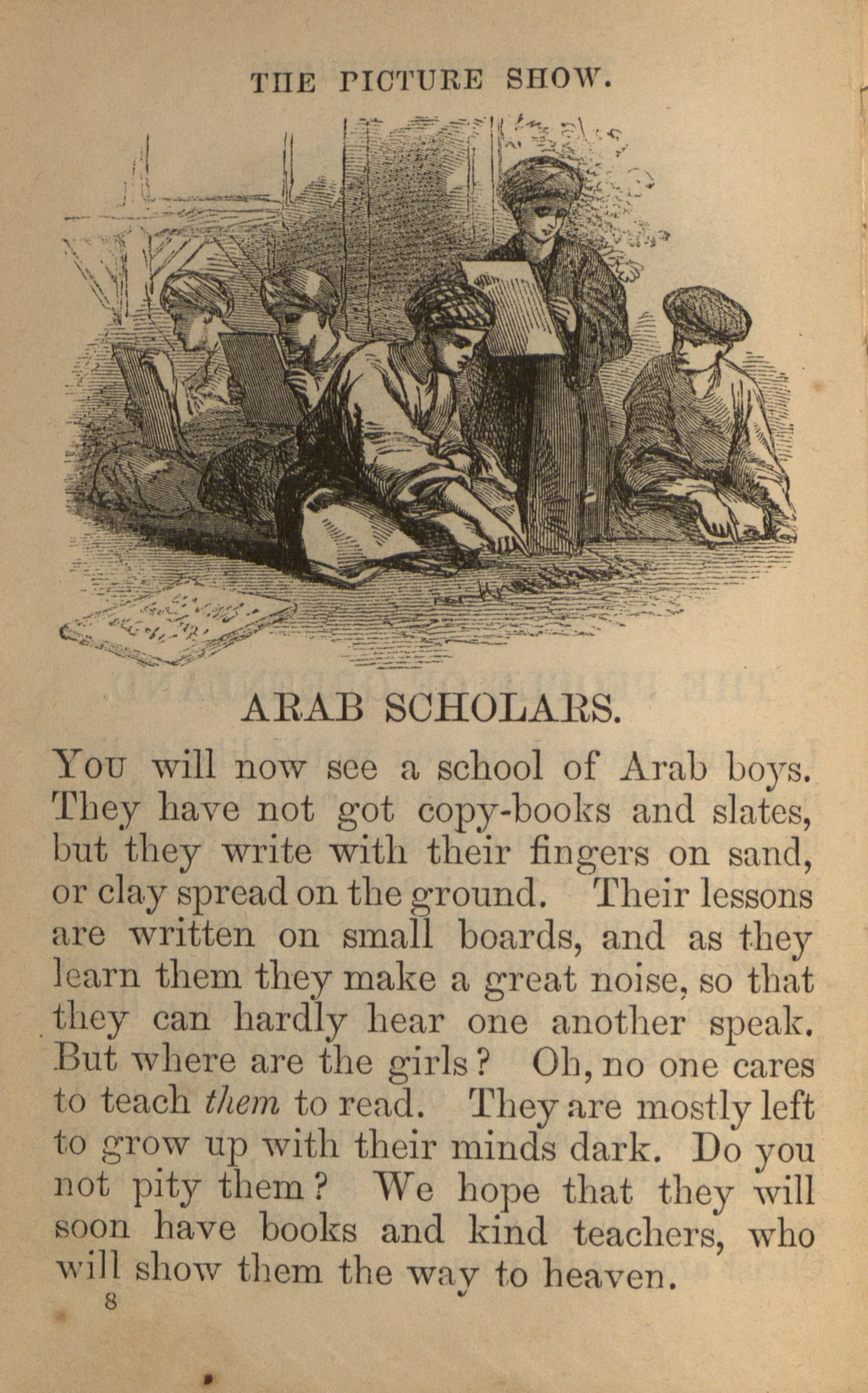Exhibit
Creation Date
1806
Height
7 cm
Width
7 cm
Medium
Genre
Description
Like "The Hindoo Woman and her Babe," this illustration and its accompanying text serve to valorize British society by favorably comparing it to a non-Christian, foreign culture. In the text accompanying this particular image, the methods of education in Arab culture are described not simply as inadequate, but also as unkind and unenlightened in its exclusion of girls. Finally, the illustration itself, by creating an image that evokes similarities between British and Arab settings, encourages moral sympathy ("pity," in the accompanying text) for foreign cultures.
Five "Arab scholars" attend to their lessons. All the boys wear loose white robes and colored turbans. The central figure sits cross-legged, his body turned to the right. He draws in the dirt with his right index finger; it is unclear what he has written. Another boy kneels behind him, holding a slate or board in his left hand. He appears to be either copying what the central figure has written or taking notes on it. To their left, another boy, seated, also observes the writing. Behind them is an opening, through which can be seen part of a tree. To the left of the central scholar, two boys sit cross-legged looking at the boards they are holding.
Images like this one were intended to teach children proper attitudes concerning Christian duties, class responsibilities, and the inferiority of non-Europeans.
While the caption below this image seems designed to emphasize the differences between the young British readers and the students in the picture, the image makes a different kind of impact. Though the boys are dressed in their native clothing and are seated on the ground, the scene is otherwise quite similar to what one might see in England. The walls are made of crossbeams that lack a distinctly Arabic appearance, and the tree outside the open door is similarly innocuous. Unlike the image from the same text, "The Hindoo Woman and her Babe," which is filled with exotic vegetation and boasts a mosque in the background, this image seems intended to evoke a comparison between the reader and the children pictured. One might simply dismiss this connection as a manifestation of the philanthropic mission of the Religious Tract Society: to promote sympathy for the heathen. However, the disconnect between the text and the image suggests that the similarity may be a result of the acknowledged but uneasy sameness of identity that existed between English children brought up in colonial settings (particularly in India) and the foreign culture surrounding them (Regaignon 84). These children were seen as “tainted” by their foreign upbringing, and there was tension regarding whether they should be considered fully British—and if so, how (Regaignon 87). This interpretation seems particularly plausible as the Arab children’s complexions, unlike that of the “Hindoo” mother and child, are not at all darkened; unusual paleness was commonly associated with a childhood in India (Regaignon 87).
As part of the “picture show” section of the book, this image recalls the peepshows popular in the late eighteenth- and early nineteenth centuries. Early peepshows consisted of large boxes with a small hole on one side through which viewers looked at images. These images were three-dimensional, and usually depicted cities, battles, landscapes, or biblical events (Ogata 69). At fairs and gatherings, peepshow men would accompany the images with spoken narration; here, the extensive labels serve the same purpose. By the early nineteenth century, peepshows made of paper—"foldout paper construction with printed scenes and a peephole"—were widely available and fairly inexpensive. They evoked the grandness of the expositions they recreated and the magic of exotic scenes; peepshows were “not only a way to inculcate lessons of nationalism and principles of taste and consumption, but also provided a form of successful entertainment" (Ogata 70). The series of images in which "A Hindoo Woman" appears is labeled and arranged to deliberately invoke the peepshow aesthetic, and shares similar aims. As the reader flips through this first section of the book, the text is presented with images from a variety of exotic scenes; consequently, the visual experience created by this collection mimics the sense of wonder and surprise elicited by the more complicated and visually rich peepshows.
Collection
Accession Number
CA 10362
Additional Information
Bibliography
Campbell, Colin. "Bewick, Thomas." Grove Art Online. Oxford Art Online. Oxford UP, 18 Jan. 2006. Web. 6 May 2009.
Kinnell, Margaret. “Scepterless, Free, Uncircumscribed? Radicalism, Dissent and Early Children’s Books.” British Journal of Educational Studies 36.1 (1988): 49-71. Print.
Ogata, Amy F. "Viewing Souvenirs: Peepshows and the International Expositions." Journal of Design History 15.2 (2002): 69-82. Print.
Regaignon, Dara Rossman. “Intimacy's Empire: Children, Servants, and Missionaries in Mary Martha Sherwood's 'Little Henry and his Bearer.' " Children’s Literature Association Quarterly 26.2 (2001): 84-95. Print.
Ruwe, Donelle. "Guarding the British Bible from Rousseau: Sarah Trimmer, William Godwin, and the Pedagogical Periodical." Children's Literature 29 (2001): 1-17. Print.
Thompson, Hilary. "Enclosure and Childhood in the Wood Engravings of Thomas and John Bewick." Children's Literature 24 (1996): 1-22. Print.

